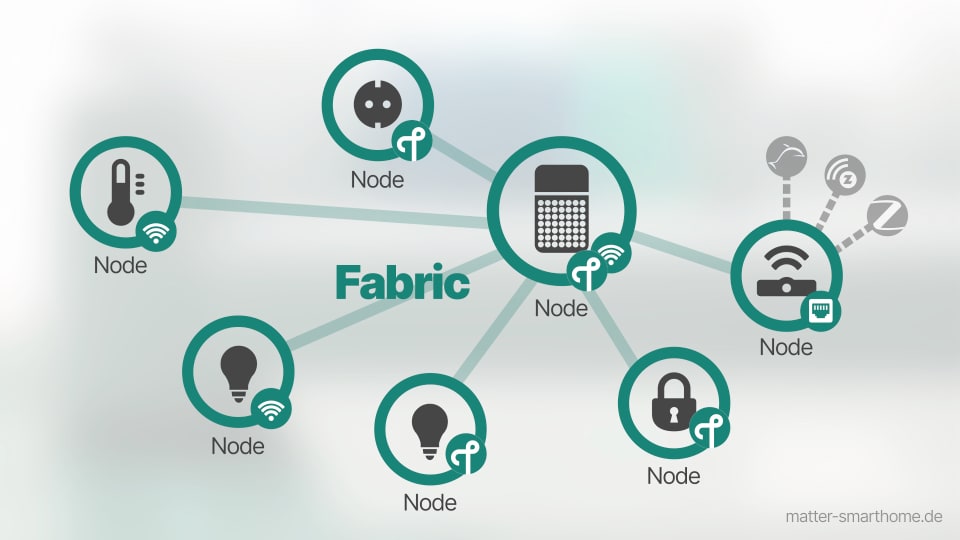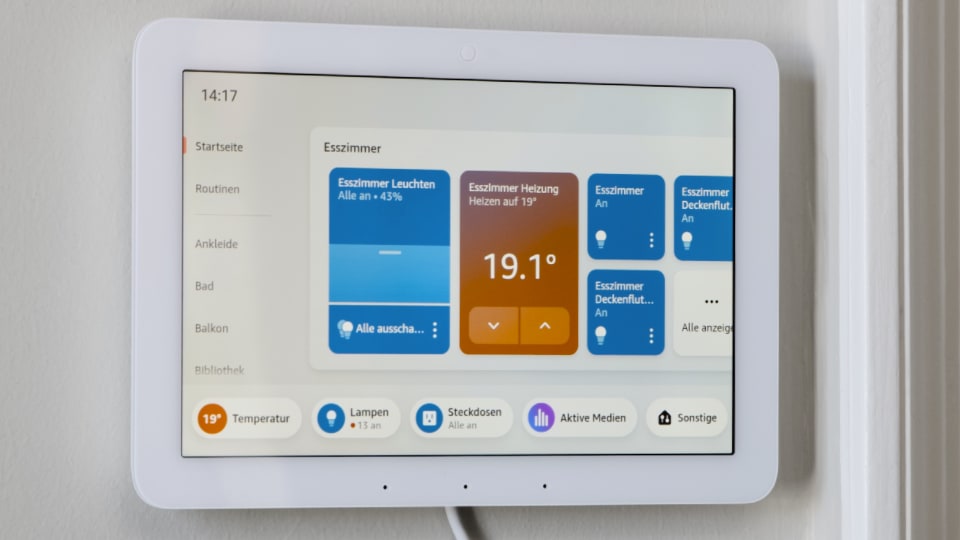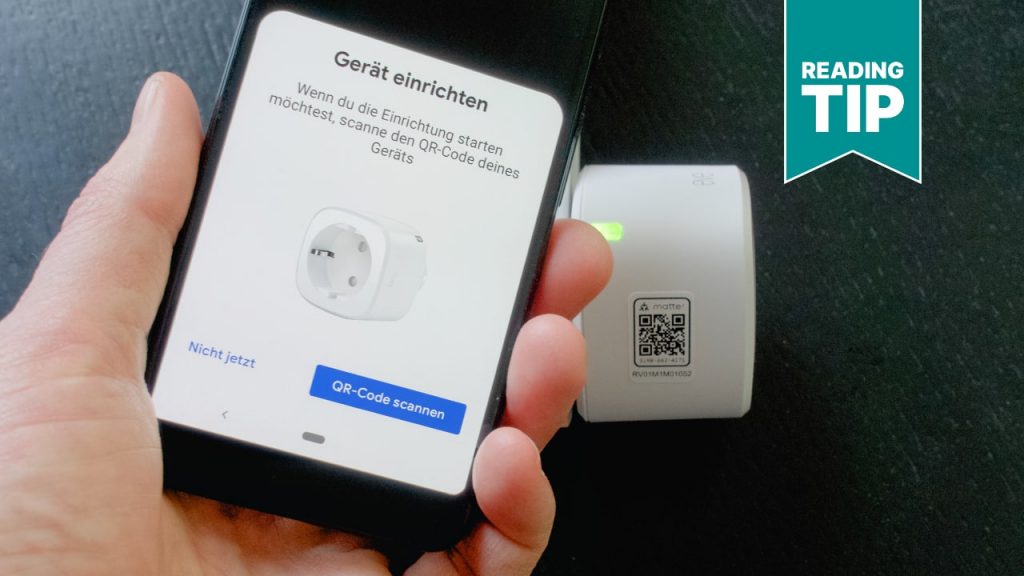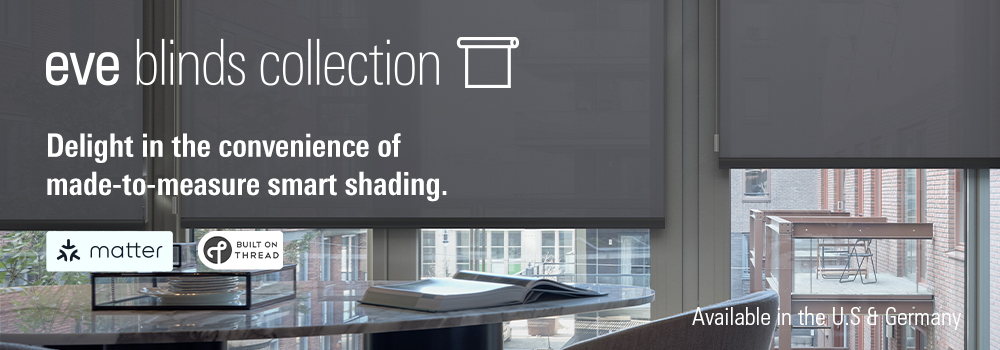The Matter smart home standard allows devices from different manufacturers to communicate with each other in the building. A central control unit takes over control and can automate processes so that lights, heating, shutters and other things react autonomously. The following instructions show how this basically works. The guide explains step by step what a Matter installation consists of and how it is set up.
Table of contents
Select a Matter platform
The most important decision is right at the start: which system should be primarily responsible for control? There are several smart home solutions that support the Matter standard and can control devices. Currently (as of March 2024), there are four major commercial Matter platforms or ecosystems:
- Amazon Alexa with the app of the same name and voice control.
- Apple Home as a progression of the former HomeKit system.
- Google Home, which combines Nest products from Google with Matter.
- SmartThings from Samsung with its own product range.
Home Assistant is also available as open-source software for DIY solutions. Tuya from China operates a platform for controlling Matter devices that is used by different companies worldwide. It appears under diverse names and with a varying range of functions.
In addition, there are smart home hubs such as Homey Pro, which have also integrated Matter and can use it for control. But be careful: They should not be confused with Matter Bridges, which merely act as intermediaries and pass on their connected devices to Matter-enabled platforms for operation.

In principle, all the Matter platforms mentioned can also be operated in parallel and installed products can therefore be controlled from different apps. This will be the subject of the fifth and final section of this guide. However, the first system that Matter puts into operation at home also defines certain framework conditions for the subsequent installation. It is therefore advisable to choose carefully.
Hardware requirements
One factor in the decision is the hardware required. Almost all platforms rely on certain products to control the smart home. An “Apple Home”, for example, can only be commissioned with an iPhone or iPad. In addition, an Apple hub must be installed as a Matter Controller. The Apple TV 4K (from 2nd generation), a HomePod (2nd gen.) or the HomePod mini are all suitable for this purpose. Amazon Alexa requires a compatible Echo model (link), while Google (link) and SmartThings also use their own hubs. In the case of Home Assistant, a computer running the software fulfills this task.
If a corresponding device already exists in the home, this control center also suggests the use of the respective ecosystem for Matter. However, for those starting from scratch and purchasing everything new, it should be noted that there are functional differences between the platforms. Not all ecosystems are equally advanced when it comes to Matter. Read more about this in the blog post on “The construction sites in the Matter standard”.
Using the Matter Controller
The hub of the ecosystem fulfills several tasks. Together with the associated app, it sets up new Matter devices and adds them to the secure installation. At the same time, it establishes a local connection to Matter devices. This type of control is provided for in the standard. It ensures that hub and end device communicate directly with each other – without involving the Internet. However, this does not mean that the app and control center have to do without an online connection altogether.
Providers decide how much their ecosystem depends on the cloud. Amazon’s Alexa app, for example, does not display any content on the screen offline. Neither does Google’s Nest Hub. HomePod and Apple TV at least want to connect to the iCloud occasionally to synchronize their status. In any case, the Matter Controller needs the internet to query the Distributed Compliance Ledger (DCL) database when setting up certified devices (more on this in “Matter benefits #4: Security and privacy”). This means that during setup, both the smartphone and the hub must be connected to the same WLAN and the Internet at home.
Thread Border Router
For Matter devices that use Wi-Fi (or are connected to an Ethernet port in the home network via bridge), this basic configuration is sufficient. Corresponding lamps, sockets, thermostats – and in future also household appliances such as robot vacuum cleaners or washing machines – can be commissioned and operated using it. The situation is different with products that rely on the Thread protocol. They require a Border Router to connect to the smart home.

For the sake of simplicity, platform providers integrate this functionality into their hubs. But as not all models have a built-in Border Router, you need to be careful. Otherwise, you’ll end up with an Amazon Echo, Apple TV or Nest Hub in your living room that only supports “Matter over Wi-Fi”. Products from Eve Systems, Nuki, Tridonic, Tuo and others, as well as some lights from Nanoleaf, use “Matter over Thread”. If you are planning to use such components at a later date, be sure to check for Thread when purchasing a Matter hub.
Technically, a single Border Router in the network is enough. However, additional devices do no harm. They remain in the background and automatically come into action if the active model fails. With one warning: it is currently still advisable to buy all Border Routers from the same provider. A mix of different brands in the home harbors the risk of parallel Thread networks being created in the different ecosystems, which can impair their reliability. An upcoming version of the Thread standard should solve this problem, but is still some way off.
A fundamental advantage of the Thread network is its mesh structure. Devices with a power connection such as smart plugs or lamps also serve as signal amplifiers and are able to increase the range. This means that even extensive homes can manage without additional repeaters. More on this here: “Benefits of Matter #2: the radio protocol Thread”.
Installing Matter devices
A control center of the desired smart home system is up and running? A Border Router in place, if necessary? Then you can start setting up devices. The smartphone app of the Matter ecosystem – from Amazon, Apple, Google, SmartThings and so on – serves as a tool. The setup process begins on screen via a plus sign (+) button or a menu for adding devices.
The procedure has been standardized so that manufacturers of Matter-certified devices include a setup code. It is usually attached to the housing as a label with a graphic QR code, but can also be imprinted or included on a leaflet in the packaging. This code contains all the information required for secure and encrypted commissioning. The smartphone only needs to capture it with its camera.

The system app has a scan function for this purpose and also guides the user through the next steps. During setup, the Matter device receives access credentials for the Wi-Fi or Thread network. It is given a unique name and assigned to a room for easy identification later on. If the new addition consists of a bridge with several devices, the program normally repeats the assignment until all the bridged products have been placed at their designated location in the smart home.
Differences in detail
As each platform has its own operating philosophy, there are differences in the details and design of the process. Some apps recognize new Matter devices that are automatically in set-up mode when they are switched on and offer them for installation. Others only become active after a tap on the corresponding button on the app screen.
Wi-Fi products such as sockets sometimes only support the frequency band around 2.4 GHz and complain if they come into contact with a smartphone that is registered on 5 GHz during setup. Additional steps may then be necessary during setup. However, this has nothing to do with Matter and was already the case before the standard was introduced. In general, the set-up process is quite the same.
Ultimately, all devices that are installed with the app of an ecosystem are located in the trusted communication network of this platform. The so-called Matter Fabric allows them to exchange data securely and encrypted across all connection paths. It is not relevant whether the individual device is connected via Wi-Fi, Thread or LAN cable. Whether it supports the Matter standard on its own or obtains this capability via a bridge.

Control and automation
After commissioning, the products are ready for operation. They respond to instructions in the smartphone app and to voice commands. The digital assistant of the respective system – whether Alexa, Bixby, Google Assistant or Siri – takes control without any further settings. On-screen devices such as Amazon’s Echo Hub or Google’s Nest Hub display a prepared user interface with device tiles for control. This makes switching sockets or dimming lights a breeze. The room temperature or blinds are also immediately controlled by Matter.
Initially, this kind of control only works manually or in response to individual voice commands. At most, groups of devices that are combined in a smart home scene can be operated this way. To give the installation some intelligence and make things happen on their own, automation is required. Automations – depending on the platform, also known as rules, routines or flows – allow the smart home to practically control itself. When certain conditions are met, programmed actions follow automatically. For example, the shutters are lowered in the evening or the heating controller recognizes that everyone has left the house and lowers the room temperature.

The manufacturer app for extras
Some things can’t be controlled with Matter because they are not yet part of the standard – or are not (yet) taken into account by the platforms in their user interfaces. A typical example: individual access authorizations for a smart lock that allow guests or house staff to enter the home at certain times. Graphically prepared heating schedules for shift workers with changing daily routines are also not available from Amazon, Google & Co. Device manufacturers are then free to map these functions using their own app. The Matter system manages everyday life, while the manufacturer’s software is responsible for special settings.
Share Matter devices
As mentioned, the Matter Fabric of a platform connects devices with each other – like an encrypted chat group in a Messenger, that offers a secure communication space. But as each ecosystem creates its own fabric during installation, participants from other systems are inevitably being locked out. This means that Matter devices set up on Apple’s platform are inherently unable to communicate with those in the Amazon, Google, SmartThings or another platform’s domain – and vice versa. Just as if one group were communicating with iMessage, the next one via WhatsApp, another in Telegram, in Signal and so on.
But the inventors of the Matter standard have provided for this situation and created a way for participants to join other groups in the household. Each device, whether an individual sensor or a bridge, can be released for use on other Matter platforms. There is a menu item for this in the system app, labeled with terms such as “pairing mode” or “other services”. Occasionally it is also referred to as “linked Matter apps”.

Activate pairing mode
The command puts a Matter device into pairing mode for a certain period of time and generates a new setup code, which can consist of digits or the familiar QR symbol. The app of the target system uses this combination, just like the manufacturer code in the first place, to integrate the device into its fabric. Shared products can then be accessed from both sides. For example, an Apple Home, which normally requires devices with an Apple operating system for control and programming, also listens to Echo speakers from Amazon or the Android apps of other systems. Operation is possible in parallel from different systems, which is why Matter calls this feature Multi-Admin Mode.
Good to know: Sharing only works with Matter end devices such as lamps, sockets, thermostats, shutter motors and so on. It is not possible to share Matter hubs that have control functions in the respective fabric. Apple’s HomePod, which also serves as a Controller, therefore cannot be used for music playback with Amazon Alexa for example. A Google speaker is not able to form multiroom groups with Echo models from the competitor. That’s another reason why it’s worth thinking about the primary smart home ecosystem in the household before installing any Matter devices.
Share this information:


